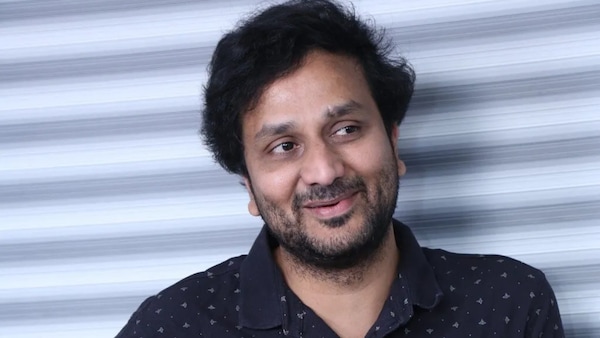Srinivas Avasarala on Phalana Abbayi Phalana Ammayi: Films enjoy recall value when you stay true to the conflicts | Exclusive

Last Updated: 12.11 AM, Mar 17, 2023
Actor, filmmaker Srinivas Avasarala, whose directorial Phalana Abbayi Phalana Ammayi (PAPA) hits theatres today, has made only three films in over a decade. Yet he manages to generate the same amount of anticipation whenever his film is up for a release.
He strikes the tough balance between realism and mainstream cinema, catering to the tastes of an average film buff and a true connoisseur. Surprisingly, he wanted to do away with his strengths for PAPA, a slice-of-life romance revolving around a couple narrated across seven chapters.
While the Naga Shaurya, Malvika Nair starrer tests its fortunes in theatres, the director holds forth on the film and his sensibilities in a chat with OTTplay.com
The ambience of the narrative are quite integral to a film like Phalana Abbayi Phalana Ammayi. When you make a film for over three years, how do you bring that consistency in the storytelling?
I don’t think there’s much of a difference between Phalana Abbayi Phalana Ammayi and other films when it comes to execution. It’s how filmmaking works - the challenge is to hold the same emotion with which the previous scene ended. Being on the set, that’s the main thing that should concern a director. He should also understand where does this piece fit in the whole puzzle. That’s the fun side to making films. The rest is taken care by the ADs, the positions, the continuity and the other little details that complete a scene.
Isn’t it a challenge to sustain a viewer’s attention when you tell a story across different chapters?
That was the most exciting part for me when I first wrote the script. I wanted to have great emotional jumps and yet be consistent in driving the story across chapters. I relished this challenge as a storyteller while making it.
The headspace while shifting roles from a director to an actor
It’s not confusing because I look at filmmaking like one craft. Sometimes, there are people to support you. When you’re making a film at a lower scale, you need to carry your own costumes to sets. As long as you have a final image in mind and work towards achieving that - I don’t see any difference between the crafts.
Looking beyond his strengths - dialogue writing and humour - in Phalana Abbayi Phalana Ammayi
I intentionally wanted to break the mould and it wasn’t difficult. Audiences in this industry always remember you for your last film and it’s quite unfair for them to look beyond that. It’s equally unfair to yourself when you don’t give them much beyond that last film. While people were curious to watch Oohalu Gusagusalade before release, they eventually liked it because of the dialogues and called it my strength.
Every film presents an opportunity to showcase a newer dimension of myself as a storyteller. When I first gave the script to my friends, they said it didn’t have the fun element of Oohalu.. and Jyo Achyutananda. I said them that was exactly my intention; to make a film beyond the humour and the dialogues.
Both your films as a director Jyo Achyutananda and Oohalu Gusagusalade enjoy terrific recall value even today. How do you make a film that enjoys a long shelf life?
It’s not a formula, yes, but films work for different reasons. I make films based on my experiences and my learnings from a film school. There are schools of filmmaking where you tailor your script imagining how would audiences react to it. If you’re depending on audience’s collective energy for a scene to work in theatres, you won’t have the same fun while watching the film on OTT or television.
You can probably ensure recall value by going back to basics, staying true to the conflicts. A good film should work even after five decades of its release. It’s easy to insert few pop-culture references or trending jokes to grab eyeballs, but that might not add much value to the film later and even weakens the narrative.
Harini Rao’s turn from a singer to an actor was something not many foresaw. How was it dealing with a non-actor sans any baggage?
I wasn’t looking at her as a non-actor. She’s a good friend of mine and whenever we meet, the conversations are so wacky and funny. When I wrote this character, I wanted her to bring that aspect of the personality to the scene. She does have a funny bone and I hope it reflects on the screen.
I didn’t view Harini as a newcomer and just thought she’d do justice to the part. I would definitely want to work with her again because she understands art. She wants to stay true to her part and doesn’t want to be somebody. Once you find someone as dedicated as that, you would want to explore more of her strengths.
Phalana Abbayi Phalana Ammayi looks like a film that’s very today and yet the album has the charm of a yesteryear classic
For this film, I wanted to produce music that’ll trigger your nostalgia; it was a conscious choice. It comes a little easy to me and Kalyani because of our shared fascination for old Hindi film music - that’s where the album has come from.
Getting director Mohana Krishna Indraganti to sing Neeli Meghamalavo..
When we were deciding the singer for the number, we knew it needed to have some recall value. If you watch the release trailer, the song needs to play in the background but it needs to have a peculiar quality to it. It’s also a cover version of an original song. I suggested the idea to Kalyani (Malik), thought about it for a while and went ahead with it.
When I initially wrote this scene in the film, I had another song in my mind. I wasn’t paying much attention to it because it should sound like you’re hearing it for the first time - I wanted it to be fresh, impactful and still have a dejavu vibe to it. I remembered Chaudhvin Ka Chand had a Telugu version too (from Madana Kamaraju Katha). It’s not as famous as the original song but it’s still known among a few - it fit the bill perfectly.
Why has romance been a common thread in all your films to trigger the core conflict?
I disagree with the thought that romance triggered the conflict in Jyo Achyutananda, but you’re right about Oohalu Gusagusalade and Phalana Abbayi Phalana Ammayi. When I was making Oohalu.., I wasn’t sure if I would be able to handle the emotion correctly. It was my first film and I wanted to make a breezy entertainer. Luckily, Shaurya came on board and the charm and the humour worked.
When I wanted to take up something more emotional and serious, Jyo Achyutananda came to my mind. The screenplay was innovative with the humour and the emotions worked out very well in the climax. I gained confidence with the film. In PAPA, I’m trying to deal with emotions in a deeper way. I don’t think of Sanjay and Anupama in the film as a boy and a girl - I see them as two people.
People and relationships always interest me. I enjoyed exploring the dynamics between brothers in Jyo and I also wanted to make a film focusing on the father-son equation. I watched a video of the standup comedian Zakir Khan talking about his father and it piqued my interest to write something on their relationship.
For a film that you wanted to be realistic and have the vibe of an indie effort, why did you pick two mainstream actors?
Whenever I watched indie films, I realised it was actors who were holding the fort beyond the soundscape. In a realistic film, actors are your main pillars. If I pick newcomers for this story, I was worried if they would fizzle out or not perform as per my expectations. What if the actors can’t hold a scene in such an ambience? Actors are always looking to experiment, upgrade themselves and find new ways to approach a role. The process of making Shaurya, Malvika slip into the shoes of Sanjay and Anupama was exciting.

 Premium
Premium